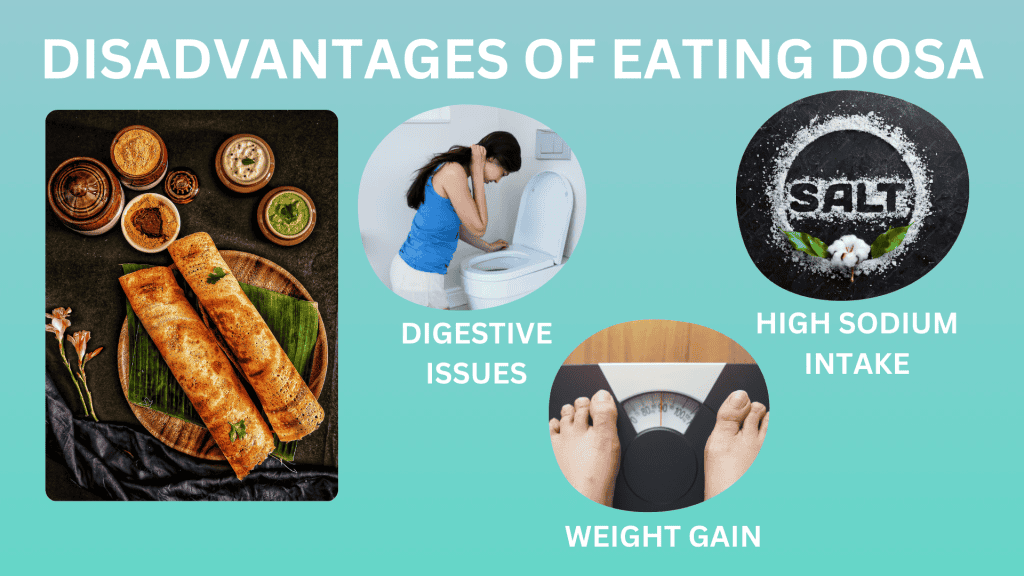Disadvantages of Dosa include the risk of eating contaminated batter, the potential for high sodium intake from accompaniments, and possible digestive problems due to overfermentation or improper preparation. Overfermentation of batter can cause digestive issues such as bloating and discomfort, and eating dosa in large amounts might lead to weight gain as well. Additionally, the traditional ways of making dosa often use a lot of oil. This makes the food have more calories and can cause high cholesterol levels.
Another side effects of dosa is that chutneys and sambar are served with dosa. It usually contains a lot of salt, and eating too much salt can cause blood pressure to go up. There is also the risk of consuming contaminated batter, which can cause food-related diseases. To eat dosa in a healthy way, it is essential to use a little oil, add vegetables, eat small portions, and pick side dishes with low salt. Knowing these effects of dosa and making intelligent choices can let you enjoy dosa without risking your health.
Are There Disadvantages of Eating Dosa?
Yes, eating dosa has several disadvantages, even though it’s popular and has nutritional benefits. For example, eating dosa made from contaminated batter can lead to food poisoning. The chutneys and sambar that are mostly served with dosa contain high sodium levels, which may lead to hypertension. Over-fermentation of the batter can result in a sour taste and digestive issues, making preparing and consuming dosa carefully important. One must be cautious while eating dosas if they follow the How to lose 5 kg in 5 days routine because it is not usually recommended for fast weight loss and may not be advantageous for health.
Reasons Behind Disadvantages of Eating Dosa
One of the disadvantages of eating dosa is that the batter can sometimes ferment too much, making it too sour and causing digestive problems. And if you eat too many dosas, you might end up with an imbalanced diet that’s high in carbohydrates, leading to weight gain and blood sugar spikes. Plus, traditional dosa preparation often uses a lot of oil, which increases the calorie count and can raise cholesterol levels. The chutneys and sambar served with dosa are tasty, but they often have high sodium levels, which can increase blood pressure.
So, it’s important to watch out for these side effects of dosa and look out for Zero calorie foods options in dosas. So, While dosa is tasty and nutritious, there are several side effects of eating dosa:
1. Over-fermentation
When the batter ferments too much, it becomes too sour and can cause digestive problems. Fermentation is a delicate process that must be monitored closely. If the batter is left to ferment for too long, it can develop a sour taste. This over-fermentation can make the dosa challenging to digest, leading to symptoms such as bloating, gas, and stomach discomfort.
2. Excessive Consumption
Regularly eating a large number of dosas might result in consuming more calories than needed, leading to weight gain. Eating too many dosas, especially without balancing them with protein rich foods and vegetables, can result in a high carbohydrate intake.
3. Preparation Methods
Using too much oil while making dosa can increase its calorie content and make it unhealthy. Traditional dosas can be high in calories due to the amount of oil used during cooking. Excess oil increases the calorie count and can contribute to high cholesterol levels and weight gain. It’s better to use a non-stick pan or minimal oil to keep the dosa healthy.
4. High-Sodium Accompaniments
Chutneys and sambar served with dosa often have high sodium levels. High sodium intake can increase blood pressure and pose risks for heart disease. Dosa is usually served with accompaniments like chutneys and sambar, which can be high in sodium. High sodium intake is associated with increased blood pressure, which can lead to cardiovascular diseases. It’s important to be mindful of the sodium content in these accompaniments and opt for low-sodium versions when possible.
5. Risk of Contamination
The batter can get contaminated if it’s not stored or handled correctly, leading to stomach infections and food poisoning. The batter used to make dosa needs to be appropriately stored to prevent contamination. If the batter is left out at room temperature for too long, it can become a breeding ground for bacteria. Always store the batter in the refrigerator and use it within a safe time frame to avoid the side effects of dosas.
6. Nutrient Imbalance
A diet heavy in carbohydrates without adequate protein and fiber can result in poor nutrition and related health problems. Pair dosa with protein-rich foods like lentils and fibre-rich vegetables to ensure a well-rounded meal.
Tips to Make Consumption of Dosa Healthy
Eating dosa can be good for your health if you use little oil or cook it on a non-stick pan. This way, you lower calories and keep the dosa light to make it fall in the category of low calorie foods, so there is no need to worry about high cholesterol. Also, a nice idea is to put vegetables in the batter. Putting finely chopped vegetables into dosas gives them more fiber and nutrients, making them healthier and tastier. It is easy to eat too many dosas because they are delicious, but controlling how much you eat can help keep a balanced diet. However, it is also good to know the disadvantages of eating dosa, such as getting too many carbs or possibly harmful effects, especially if the dosa has lots of oil or spices.
To eat dosa in a healthy way, think about these suggestions:
- Use Little Oil: Cook with a bit of oil or use a non-stick pan. This way, the dosa stays light and helps lower the chances of high cholesterol.
- Add Vegetables: Finely chopped vegetables can be added to the batter to add more fiber and nutrients. This makes the dosa not just healthier but also gives it a nice taste and feel.
- Control Portion Size: Try to eat fewer dosas, as this will help you avoid eating too much and keep your diet balanced.
- Pick Low-Sodium Side Dishes: Try making chutneys at home with less salt or using different spices. This helps to lower the chance of getting high blood pressure and makes your meal better for heart health.
- Make Sure Fermentation is Right: Let the batter ferment correctly so it helps with digestion and prevents sour taste. Good fermentation also helps in better digestion and makes dosa more nutritious.
- Use Whole Grains: To make a meal more nutritious, you can replace white rice with whole grains or millet. These whole grains add extra fiber, vitamins, and minerals to your diet, making dosa better for your health.
What is the Best Time to Eat Dosa for Health Benefits?
The best time to eat dosa is in the morning or at lunch to avoid the disadvantages of eating dosa. Eating dosa for breakfast gives you a good source of energy to start the day while having it for lunch ensures your body has enough time to digest the meal. Eating dosa in the evening or at night might not be ideal because it might not be digested as easily before bedtime. When eaten in the morning, dosa provides essential carbohydrates and protein to provide energy for the whole day, while at lunch, it serves as a great meal that can be digested throughout the afternoon. Consuming dosa earlier in the day allows your body to utilize carbohydrates effectively for energy, preventing them from being stored as fat.
Healthy Dosa Recipes to Eat
When it comes to finding healthier meal options, sometimes it’s all about giving traditional dishes a nutritious twist. Dosas are a perfect example of this. Let’s explore amazing variations of dosas like Oats, ragi, Vegetable, Moong Daal, and Quinoa Dosa. These not only taste great but also offer a ton of health benefits, making them ideal for a balanced diet.
1. Oats Dosa
Oats Dosa is fantastic because it’s made with oats and just a little oil. They are packed with soluble fiber, which is great for heart health and helps with digestion. Plus, this dosa is lighter than the usual kind and keeps you full longer thanks to its high fiber content. It’s a great way to start your day feeling satisfied and healthy.
2. Ragi Dosa
Then there’s Ragi Dosa, which uses ragi flour. Ragi, or finger millet, is loaded with calcium and protein, making it excellent for your bones. It’s also a good source of iron. So, if you need to boost your calcium and iron intake, this dosa is a perfect choice. It’s not just healthy but also incredibly tasty.
3. Vegetable Dosa
Now, let’s talk about Vegetable Dosa. This one involves adding veggies like carrots, spinach, and bell peppers to the batter. This not only boosts the nutritional value but also makes the dosa delicious. With all those vitamins, minerals, and fiber, this dosa becomes a balanced meal that’s both nutritious and satisfying.
4. Moong Dal Dosa
Moong Dal Dosa is another great option. Made with moong dal, or green gram, this dosa is high in protein and fiber. It’s light and easy to digest, making it an excellent choice for a healthy breakfast or a snack. If you’re looking to up your protein intake without feeling too heavy, this is the dosa for you.
5. Quinoa Dosa
Finally, there’s the Quinoa Dosa, which includes quinoa, a superfood. Quinoa is rich in protein, fiber, iron, and magnesium and contains all nine essential amino acids, making it a powerhouse of nutrients. This dosa is perfect if you want to add some variety to your diet while boosting your energy and muscle health.
Side Effects of Eating Dosa
While dosa is generally a healthy choice, eating it improperly can have some side effects if the batter is over-fermented; it can lead to digestive problems like bloating and stomach discomfort. This happens because the excess sourness from the over-fermentation can irritate your stomach lining. Plus, there are some more disadvantages of eating dosa with salty accompaniments like chutneys and sambar: you might take in too much sodium. High sodium intake is linked to higher blood pressure and can strain your heart and kidneys. To ensure that Is dosa good for weight loss, it’s essential to eat it in moderation and to ensure that the batter is to avoid these potential side effects of dosa.
1. Digestive Issues
Over-fermented batter can cause bloating and discomfort. The excess sourness from overfermentation can irritate the stomach lining, leading to gas, bloating, and discomfort. Therefore, it is important to ensure the batter is fermented just right.
2. Weight Gain
Excessive consumption of dosa, especially with high-calorie accompaniments, can contribute to weight gain. High oil content and large portions can add extra calories to your diet. Overeating dosas, particularly those made with a lot of oil or accompanied by rich, fatty sides, can lead to consuming more calories than your body needs, causing weight gain.
3. High Sodium Intake
Eating dosas with salty accompaniments can lead to increased blood pressure. High sodium levels are linked to various heart-related issues and can affect kidney function. Chutneys and sambar can also increase blood pressure and strain the cardiovascular system.
Is Dosa Good for Weight Loss?
Dosa can be part of a weight-loss diet if you eat it in moderation and prepare it healthily. Choosing versions made with whole grains and minimal oil can provide essential nutrients without adding too many calories. However, it’s crucial to balance dosa consumption with other protein-rich and fiber-rich foods to maintain a balanced diet. Including plenty of vegetables and using less oil makes dosa a lower-calorie option suitable for weight management. Plain Dosa provides 17g of carbohydrates, 3.1g of protein, and 2.6g of fat per serving, and Masala Dosa offers 23g of carbohydrates, 3.7g of protein, and 5.6g of fat per serving, owing to its potato filling. Whole grain dosas, like those made with ragi or oats, are higher in fibre, which can help you feel fuller and longer and reduce overall calorie intake.
Expert Review on Disadvantages of Eating Dosa
Dr Sakshi Gupta, a nutrition expert, recommends that, While dosa can be a healthy dish, it is important to be mindful of its preparation and consumption. Overfermentation, excessive oil use, and high-sodium accompaniments can nullify its health benefits. Moderation and balanced sides are key to enjoying dosa healthily. This expert insight focuses on the importance of how dosa is prepared and consumed in determining its health effects. Dr Sakshi highlights the need for balance and moderation to enjoy the benefits of dosa without experiencing its potential drawbacks.
References
“Is dosa good for health? 9 Reasons to Eat Dosa Everyday.” n.d. Sankalp Packaged Foods. Accessed June 18, 2024. https://shop.sankalpfoods.com/reasons-to-eat-dosa-everyday/.
Patel, Sidra. n.d. “Calories in Dosa – Health Benefits & Nutritional Facts | Ritebite Max Protein.” RiteBite Max Protein. Accessed June 18, 2024. https://maxprotein.in/blogs/calories/dosa-calories-nutrition-and-health-benefits.
Thakur, Shalini. 2023. “Disadvantages Of Eating Dosa: The Flip Side Of Dosa.” Fitelo. https://fitelo.co/resources/articles/disadvantages-of-eating-dosa/.
FAQs
1. What happens if we eat dosa daily?
Eating dosa daily can be beneficial because its fermented combination of rice and lentils makes it easy to digest and gives you high energy. The carbohydrates in the dosa are essential for bodily functions, supporting brain health, and maintaining stable blood sugar levels.
2. Is dosa healthy or unhealthy?
Dosa is a healthy dish but should be consumed in moderation due to the high rice content. The fermentation process gives the dosa batter a good amount of essential amino acids, making it highly nutritious with low enzyme inhibitors and phytic acid levels.
3. Is it okay to eat dosa at night?
Eating dosa at night is fine if you prepare it in a traditional style with less oil and more stuffing of leafy green vegetables. One plain dosa provides only 165 of the 2000 calories an average weight adult requires daily.
4. Is dosa hard to digest?
Dosa is a fermented breakfast meal that is easier for your body to digest. The fermentation process breaks down complex carbohydrates, making them easier to digest. You can also use other healthy ingredients like rice, rawa, or oats to alter the taste and calorie count, making it even easier on your digestive system.









